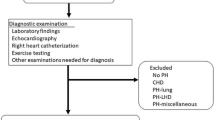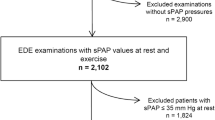Abstract
Resting two-dimensional speckle tracking echocardiography (2D-STE) identified right ventricular (RV) systolic function were reported to predict exercise capacity in pulmonary hypertension (PH) patients, but little attention had been payed to 2D-STE detected RV diastolic function. Therefore, we aim to elucidate and compare the relations between 2D-STE identified RV diastolic/systolic functions and peak oxygen consumption (PVO2) determined by cardiopulmonary exercise testing (CPET) in pre-capillary PH. 2D-STE was performed in 66 pre-capillary PH patients and 28 healthy controls. Linear correlation and multivariate regression analyses were performed to evaluate and compare the relations between RV 2D-STE parameters and PVO2. Receiver operating characteristic curves were used to compare the predictive value of 2D-STE parameters in predicting the cut-off—PVO2 < 11 ml/min/kg. There were significant differences of all the 2D-STE parameters between PH patients and healthy controls. In patients, RV-peak global longitudinal strain (GLS, rs = − 0.498, P < 0.001), RV- peak systolic strain rate (GSRs, rs = − 0.537, P < 0.001) and RV- peak early diastolic strain rate (GSRe, rs = 0.527, P < 0.001) significantly correlated with PVO2, but no significant correlation was observed between RV- peak late diastolic strain rate (GSRa, rs = 0.208, P = 0.093) and PVO2. The first multivariate regression analysis of clinical data without echocardiographic parameters identified WHO functional class, NT-proBNP and BMI as independent predictors of PVO2 (Model-1, adjusted r2 = 0.421, P < 0.001); Then we added conventional echocardiographic parameters and 2D-STE parameters to the clinical data, identified S,(Model-2,adjusted r2 = 0.502, P < 0.001), RV-GLS (Model-3, adjusted r2 = 0.491, P < 0.001), RV-GSRe (Model-4, adjusted r2 = 0.500, P < 0.001) and RV-GSRs (Model-5, adjusted r2 = 0.519, P < 0.001) as independent predictors of PVO2, respectively. The predictive power was increased, and Model-5 including RV-GSRs showed the highest predictive capability. ROC curves found RV-GSRs expressed the strongest predictive value (AUC = 0.88, P < 0.001), and RV-GSRs > − 0.65/s had a 88.2% sensibility and 82.2% specificity to predict PVO2 < 11 ml/min/kg. 2D-STE assessed RV function improves the prediction of exercise capacity represented by PVO2 in pre-capillary PH.
Graphical abstract




Similar content being viewed by others
References
Galie N, Humbert M, Vachiery JL et al (2015) 2015 ESC/ERS Guidelines for the diagnosis and treatment of pulmonary hypertension: The Joint Task Force for the Diagnosis and Treatment of Pulmonary Hypertension of the European Society of Cardiology (ESC) and the European Respiratory Society (ERS): Endorsed by: Association for European Paediatric and Congenital Cardiology (AEPC), International Society for Heart and Lung Transplantation (ISHLT). Eur Respir J 46(4):903–975. https://doi.org/10.1183/13993003.01032-2015
D’Alonzo GE, Barst RJ, Ayres SM et al (1991) Survival in patients with primary pulmonary hypertension. Results from a national prospective registry. Ann Intern Med 115(5):343–349
Humbert M, Sitbon O, Chaouat A et al (2010) Survival in patients with idiopathic, familial, and anorexigen-associated pulmonary arterial hypertension in the modern management era. Circulation 122(2):156–163. https://doi.org/10.1161/CIRCULATIONAHA.109.911818
Benza RL, Miller DP, Gomberg-Maitland M et al (2010) Predicting survival in pulmonary arterial hypertension: insights from the Registry to Evaluate Early and Long-Term Pulmonary Arterial Hypertension Disease Management (REVEAL). Circulation 122(2):164–172. https://doi.org/10.1161/CIRCULATIONAHA.109.898122
Arena R, Lavie CJ, Milani RV et al (2010) Cardiopulmonary exercise testing in patients with pulmonary arterial hypertension: an evidence-based review. J Heart Lung Transplant 29(2):159–173. https://doi.org/10.1016/j.healun.2009.09.003
Wensel R, Opitz CF, Anker SD et al (2002) Assessment of survival in patients with primary pulmonary hypertension: importance of cardiopulmonary exercise testing. Circulation 106(3):319–324
Piepoli MF, Corra U, Agostoni PG et al (2006) Statement on cardiopulmonary exercise testing in chronic heart failure due to left ventricular dysfunction: recommendations for performance and interpretation Part II: How to perform cardiopulmonary exercise testing in chronic heart failure. Eur J Cardiovasc Prev Rehabil 13(3):300–311
Rehman MB, Garcia R, Christiaens L et al (2018) Power of resting echocardiographic measurements to classify pulmonary hypertension patients according to European society of cardiology exercise testing risk stratification cut-offs. Int J Cardiol 257:291–297. https://doi.org/10.1016/j.ijcard.2018.01.042
Hardegree EL, Sachdev A, Villarraga HR et al (2013) Role of serial quantitative assessment of right ventricular function by strain in pulmonary arterial hypertension. Am J Cardiol 111(1):143–148. https://doi.org/10.1016/j.amjcard.2012.08.061
Li Y, Xie M, Wang X et al (2013) Right ventricular regional and global systolic function is diminished in patients with pulmonary arterial hypertension: a 2-dimensional ultrasound speckle tracking echocardiography study. Int J Cardiovasc Imaging 29(3):545–551. https://doi.org/10.1007/s10554-012-0114-5
Calcutteea A, Lindqvist P, Soderberg S et al (2014) Global and regional right ventricular dysfunction in pulmonary hypertension. Echocardiography 31(2):164–171. https://doi.org/10.1111/echo.12309
Sunbul M, Kepez A, Kivrak T et al (2014) Right ventricular longitudinal deformation parameters and exercise capacity: prognosis of patients with chronic thromboembolic pulmonary hypertension. HERZ 39(4):470–475. https://doi.org/10.1007/s00059-013-3842-y
Naderi N, Ojaghi HZ, Amin A et al (2013) Utility of right ventricular strain imaging in predicting pulmonary vascular resistance in patients with pulmonary hypertension. Congest Heart Fail 19(3):116–122. https://doi.org/10.1111/chf.12009
Sachdev A, Villarraga HR, Frantz RP et al (2011) Right ventricular strain for prediction of survival in patients with pulmonary arterial hypertension. Chest 139(6):1299–1309. https://doi.org/10.1378/chest.10-2015
Utsunomiya H, Nakatani S, Okada T et al (2011) A simple method to predict impaired right ventricular performance and disease severity in chronic pulmonary hypertension using strain rate imaging. Int J Cardiol 147(1):88–94. https://doi.org/10.1016/j.ijcard.2009.08.009
Sutherland GR, Di Salvo G, Claus P et al (2004) Strain and strain rate imaging: a new clinical approach to quantifying regional myocardial function. J Am Soc Echocardiogr 17(7):788–802. https://doi.org/10.1016/j.echo.2004.03.027
Kittipovanonth M, Bellavia D, Chandrasekaran K et al (2008) Doppler myocardial imaging for early detection of right ventricular dysfunction in patients with pulmonary hypertension. J Am Soc Echocardiogr 21(9):1035–1041. https://doi.org/10.1016/j.echo.2008.07.002
Shiina Y, Funabashi N, Lee K et al (2009) Right atrium contractility and right ventricular diastolic function assessed by pulsed tissue Doppler imaging can predict brain natriuretic peptide in adults with acquired pulmonary hypertension. Int J Cardiol 135(1):53–59. https://doi.org/10.1016/j.ijcard.2008.03.090
Rudski LG, Lai WW, Afilalo J et al (2010) Guidelines for the echocardiographic assessment of the right heart in adults: a report from the American Society of Echocardiography endorsed by the European Association of Echocardiography, a registered branch of the European Society of Cardiology, and the Canadian Society of Echocardiography. J Am Soc Echocardiogr 23(7):685–713. https://doi.org/10.1016/j.echo.2010.05.010 (786–788)
Li AL, Zhai ZG, Zhai YN et al (2018) The value of speckle-tracking echocardiography in identifying right heart dysfunction in patients with chronic thromboembolic pulmonary hypertension. Int J Cardiovasc Imaging 34(12):1895–1904. https://doi.org/10.1007/s10554-018-1423-0
Filusch A, Mereles D, Gruenig E et al (2010) Strain and strain rate echocardiography for evaluation of right ventricular dysfunction in patients with idiopathic pulmonary arterial hypertension. Clin Res Cardiol 99(8):491–498. https://doi.org/10.1007/s00392-010-0147-5
Rain S, Handoko ML, Trip P et al (2013) Right ventricular diastolic impairment in patients with pulmonary arterial hypertension. Circulation 128(18):2016–2025. https://doi.org/10.1161/circulationaha.113.001873 (1–10)
Trip P, Rain S, Handoko ML et al (2015) Clinical relevance of right ventricular diastolic stiffness in pulmonary hypertension. Eur Respir J 45(6):1603–1612. https://doi.org/10.1183/09031936.00156714
Shukla M, Park JH, Thomas JD et al (2018) Prognostic value of right ventricular strain using speckle-tracking echocardiography in pulmonary hypertension: a systematic review and meta-analysis. Can J Cardiol 34(8):1069–1078. https://doi.org/10.1016/j.cjca.2018.04.016
Li Y, Wang Y, Meng X et al (2017) Assessment of right ventricular longitudinal strain by 2D speckle tracking imaging compared with RV function and hemodynamics in pulmonary hypertension. Int J Cardiovasc Imaging 33(11):1737–1748. https://doi.org/10.1007/s10554-017-1182-3
Werther EA, Ingvarsson A, Smith JG et al (2019) Echocardiographic right ventricular strain from multiple apical views is superior for assessment of right ventricular systolic function. Clin Physiol Funct Imaging 39(2):168–176. https://doi.org/10.1111/cpf.12552
Ho SY, Nihoyannopoulos P (2006) Anatomy, echocardiography, and normal right ventricular dimensions. Heart 92(Suppl 1):i2–i13. https://doi.org/10.1136/hrt.2005.077875
Badagliacca R, Papa S, Valli G et al (2017) Right ventricular dyssynchrony and exercise capacity in idiopathic pulmonary arterial hypertension. Eur Respir J. https://doi.org/10.1183/13993003.01419-2016
Hu EC, He JG, Liu ZH et al (2014) Survival advantages of excess body mass index in patients with idiopathic pulmonary arterial hypertension. Acta Cardiol 69(6):673–678. https://doi.org/10.2143/AC.69.6.1000010
Gan CT, McCann GP, Marcus JT et al (2006) NT-proBNP reflects right ventricular structure and function in pulmonary hypertension. Eur Respir J 28(6):1190–1194. https://doi.org/10.1183/09031936.00016006
Hill SA, Booth RA, Santaguida PL et al (2014) Use of BNP and NT-proBNP for the diagnosis of heart failure in the emergency department: a systematic review of the evidence. Heart Fail Rev 19(4):421–438. https://doi.org/10.1007/s10741-014-9447-6
Tardif JC, Rouleau JL (1996) Diastolic dysfunction. Can J Cardiol 12(4):389–398
Nagueh SF, Appleton CP, Gillebert TC et al (2009) Recommendations for the evaluation of left ventricular diastolic function by echocardiography. Eur J Echocardiogr 10(2):165–193. https://doi.org/10.1093/ejechocard/jep007
Brutsaert DL, Rademakers FE, Sys SU et al (1985) Analysis of relaxation in the evaluation of ventricular function of the heart. Prog Cardiovasc Dis 28(2):143–163
Rehman MB, Garcia R, Christiaens L et al (2018) Power of resting echocardiographic measurements to classify pulmonary hypertension patients according to European society of cardiology exercise testing risk stratification cut-offs. Int J Cardiol 257:291–297. https://doi.org/10.1016/j.ijcard.2018.01.042
Funding
The present study was supported by the grant of Capital Health Development and Scientific Research Projects (Grant No. 2016–2-4036) and CAMS Initiative for Innovative Medical (Grant No. 2016-I2 M-3-006).
Author information
Authors and Affiliations
Contributions
All the authors take responsibility for all aspects of the reliability and freedom from bias of the data presented and their discussed interpretation.
Corresponding author
Ethics declarations
Conflicts of interest
The authors declare that they have no conflicts of interest.
Ethical approval
The present study was approved by the Ethics Committee of Fuwai Hospital (No. 2018-1063). All procedures performed in our study involving human participants were in accordance with the 1964 Helsinki declaration and its later amendments.
Informed consent
Written informed consent was obtained from all participants in this study.
Additional information
Publisher's Note
Springer Nature remains neutral with regard to jurisdictional claims in published maps and institutional affiliations.
Rights and permissions
About this article
Cite this article
Liu, BY., Wu, WC., Zeng, QX. et al. Two-dimensional speckle tracking echocardiography assessed right ventricular function and exercise capacity in pre-capillary pulmonary hypertension. Int J Cardiovasc Imaging 35, 1499–1508 (2019). https://doi.org/10.1007/s10554-019-01605-w
Received:
Accepted:
Published:
Issue Date:
DOI: https://doi.org/10.1007/s10554-019-01605-w




